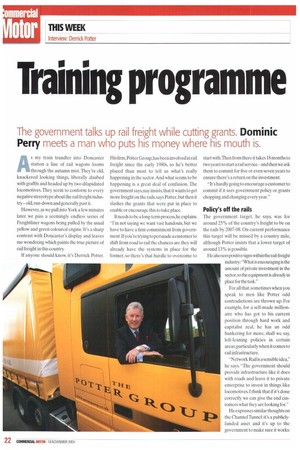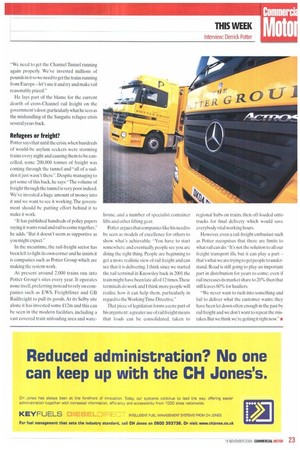Training programme
Page 22

Page 23

If you've noticed an error in this article please click here to report it so we can fix it.
The government talks up rail freight while cutting grants. Dominic Perry meets a man who puts his money where his mouth is.
As my train trundles into Doncaster station a line of rail wagons looms through the autumn mist. They're old, knackered looking things, liberally daubed with graffiti and headed up by two dilapidated locomotives. They seem to conform to every negative stereotype about the rail freight industry— old, run-down and generally past it.
However, as we pull into York a few minutes later we pass a seemingly endless series of Freightliner wagons being pulled by the usual yellow and green coloured engine. It's a sharp contrast with Doncaster's display and leaves me wondering which paints the true picture of rail freight in this country.
If anyone should know, it's Derrick Potter. His firm,Potter Group, has been involved in rail freight since the early 1980s, so he's better placed than most to tell us what's really happening in the sector. And what seems to be happening is a great deal of confusion. The government says, nay insists, that it wants to get more freight on the rails. says Potter, but then it slashes the grants that were put in place to enable or encourage this to take place.
It needs to be a long-term process, he explains. "I'm not saying we want vast handouts, but we have to have a firm commitment from government. If you're trying to persuade a customer to shift from road to rail the chances are they will already have the systems in place for the former, so there's that hurdle to overcome to start with.Then from there it takes 18 months to two years to start a rail service and then we ask them to commit for five or even seven years to ensure there's a return on the investment.
"It's hardly going to encourage a customer to commit if it sees government policy or grants chopping and changing every year."
Policy's off the rails
The government target, he says, was for around 25% of the country's freight to be on the rails by 2007-08. On current performance this target will be missed by a country mile, although Potter insists that a lower target of around 13% is possible.
He alsosees positive signs within the rail-freight industry: "What is encouraging is the amount of private investment in the sector, so the equipment is already in place for the task."
For all that, sometimes when you speak to men like Potter odd contradictions are thrown up. For example, for a self-made millionaire who has got to his current position through hard work and capitalist zeal, he has an odd hankering for more, shall we say. left-leaning policies in certain areas ;particularly when it comes to rail infrastructure.
"Network Rallis a sensible idea," he says. "The government should provide infrastructure like it does with roads and leave it to private enterprise to invest in things like locomotives. I think that if it's done correctly we can give the end customers what they are looking for."
He expresses similar thoughts on the Channel Tunnel: it's a publiclyfunded asset and it's up to the government to make sure it works: -We need to get the Channel Tunnel running again properly. We've invested millions of pounds in it so we need to get the trains running from Europe -let's use it and try and make rail reasonably priced."
He lays part of the blame for the current dearth of cross-Channel rail freight on the government's door; particularly what he sees as the mishandling of the Sangatte refugee crisis several years back.
Refugees or freight?
Potter says that until the crisis, when hundreds of would-be asylum seekers were storming trains every night and causing them to be cancelled, some 200,000 tonnes of freight was coming through the tunnel and "all of a sudden it just wasn't there". Despite managing to get some of this back, he says: "The volume of freight through the tunnel is very poor indeed. We've invested a huge amount of money into it and we want to see it working. The government should be putting effort behind it to make it work.
"It has published hundreds of policy papers saying it wants road and rail to come together," he adds. "But it doesn't seem as supportive as you might expect."
In the meantime, the rail-freight sector has been left to light its own corner and he insists it is companies such as Potter Group which are making the system work.
At present around 2,000 trains run into Potter Group's sites every year. It operates none itself, preferring instead to rely on companies such as EWS, Freightliner and GB Railfreight to pull its goods. At its Selby site alone it has invested some £12m and this can be seen in the modern facilities, including a vast covered train unloading area and ware house, and a number of specialist container lifts and other lifting gear.
Potter argues that companies like his need to be seen as models of excellence for others to show what's achievable: "You have to start somewhere and eventually people see you are doing the right thing. People are beginning to get a more realistic view of rail freight and can see that it is delivering. I think since we started the rail terminal in Knowsley back in 2001 the train might have been late all of 12 times.These terminals do work and! think more people will realise how it can help them, particularly in regard to the Working Time Directive.
That piece of legislation forms a core part of his argument: a greater use of rail freight means that loads can be consolidated, taken to regional hubs on trains, then off-loaded onto trucks for final delivery which would save everybody vital working hours.
However, even a rail-freight enthusiast such as Potter recognises that there are limits to what rail can do:"It's not the solution to all our freight transport ills, but it can play a part that's what we are trying to get people to understand. Road is still going to play an important part in distribution for years to come: even if rail increases its market share to 20% then that still leaves 80% for hauliers.
"We never want to rush into something and fail to deliver what the customer wants: they have been let down often enough in the past by rail freight and we don't want to repeat the mistakes. But we think we're getting it right now." •
























































































































































































